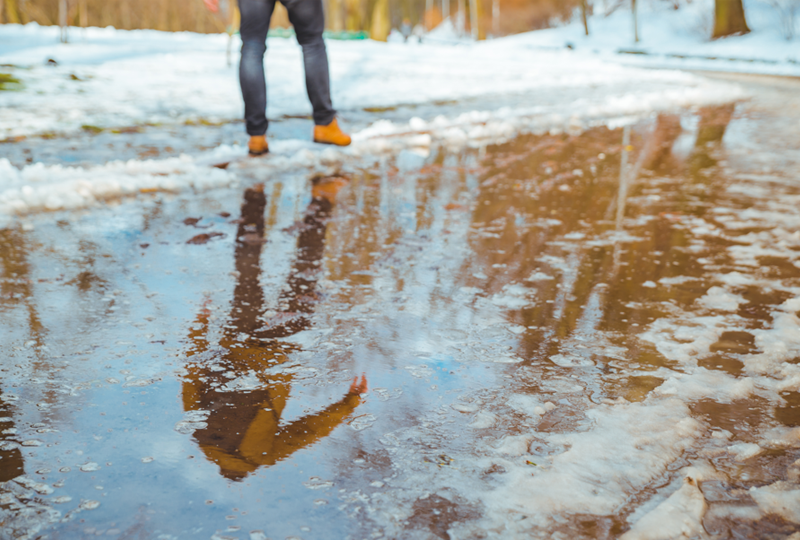
Key insights:
- As this winter’s historic snowfall begins to melt, many homeowners are worried about potential flooding in their yards and homes.
- To help prevent flooding, you can check your gutters and street drains for blockage and assess your roof for ice dams.
- Check your home for clear signs of water damage and get in touch with an expert if you aren’t sure how to handle it.
As our historic levels of snow begin to melt, it’s easy to imagine local homeowners excitedly chattering about the arrival of spring. Instead, many are focused on the potential for flooding in their homes and neighborhoods.
Here are insights you can use to help prevent flooding on your property — and advice on when to call a professional if you notice water damage in your home, yard or streets.
Watch for pooling water near storm drains
At this point, who hasn’t been amazed by the giant pools of water and slush we encounter as we drive through our neighborhoods or walk the dog? It’s easy to focus on taking cover from the impending deluge as a car drives by, but smart homeowners (and good citizens) can also work to uncover snow drains that may be blocked off from ice or snow build up.
Those blocked drains can cause the snowmelt to pool up on our streets and into our yards; they can also lead to backups in basements. If you can spare 10-15 minutes, head out on your block with a shovel or sharp tool that can help break up the ice or snow that’s covering your closest storm drain.
If you don’t know where the closest drains are located, Google your address and click on “Street View” within the Google Maps function. The Google team takes snapshots of your neighborhood in snow-free months, so you can zoom in on your curbs to locate the storm drains near your property. Some cities like St. Paul even offer residents the opportunity to adopt a drain and pledge to keep it clean and free-flowing.
Check your roof for snow drifts and ice dams
Of course, it’s not just the snow on the ground that’s causing trouble for local homeowners. Roof build-up can lead to ice dams, which cause water damage as the melting snow seeps through your shingles and into walls and insulation. Professionals are saying that ice dams are at their worst in 20 years or more, so you are certainly not alone if your icicles are looking extra treacherous this year.
We are likely past the point of being able to prevent ice dams, though specialists do recommend removing large, heavy drifts of snow from your roof if possible (Hint: Buy a roof rake). It can also help to check that your gutters are draining and that your downspouts are positioned to help runoff flow away from your property.
If you notice that your house is showing signs of ice dams, contact a professional immediately and be prepared to wait a few days (and spend a few dollars) due to the number of homeowners who are in similar situations.
Know the signs of water damage
Start by checking your basement and exterior foundation for standing water, then explore your attic for signs that ice dams are causing interior damage. Call for professional help if either of these signs are present. You’ll also want to move valuables and papers to safer locations in the event that your basement floods.
Once you’ve confirmed that there isn’t risk of immediate flooding or major roof damage, you can look for smaller indications of water damage in your house. We recommend assessing:
- Walls and ceilings for stains and sagging
- Your roof for missing or damaged shingles, as well as leaks, cracks or damage around the chimney
- Basement drywall, which is at a higher risk for mold
If you have a dehumidifier, we recommend running it in your basement until the snow has fully melted and your water damage risk has sufficiently decreased. You should also check that your sump pump is in working order if you have one, and seal all cracks in your foundation with weatherproof caulk or spray foam.
Consider flood insurance
A typical homeowners insurance policy doesn’t cover flood insurance, so it’s important to consider a secondary flood insurance policy if you think you’re at risk of major damage from flooding. Depending on the provider, it can take 30 days for flood insurance to go into effect, so it’s important to act quickly if you think you’re at risk of flood damage this year.
How to determine your need for flood insurance
Need more homeowner insights?
Assessing and preventing flood damage can be a daunting task, but it can also help you save hundreds or even thousands of dollars in the long run. And remember, snow melting is a sure sign that winter is coming to an end. So if you really need a silver lining as you perform this one last winter weather task, here it is: Spring. Is. Coming. We promise.
For even more homeowner tips, check out Edina Realty insights.









 ©2025 Prosperity Home Mortgage LLC®. (877) 275-1762. 3060 Williams Drive, Suite 600, Fairfax, VA 22031. All first mortgage products are provided by Prosperity Home Mortgage, LLC®. Not all mortgage products may be available in all areas. Not all borrowers will qualify. NMLS ID #75164 (For licensing information go to: NMLS Consumer Access at
©2025 Prosperity Home Mortgage LLC®. (877) 275-1762. 3060 Williams Drive, Suite 600, Fairfax, VA 22031. All first mortgage products are provided by Prosperity Home Mortgage, LLC®. Not all mortgage products may be available in all areas. Not all borrowers will qualify. NMLS ID #75164 (For licensing information go to: NMLS Consumer Access at